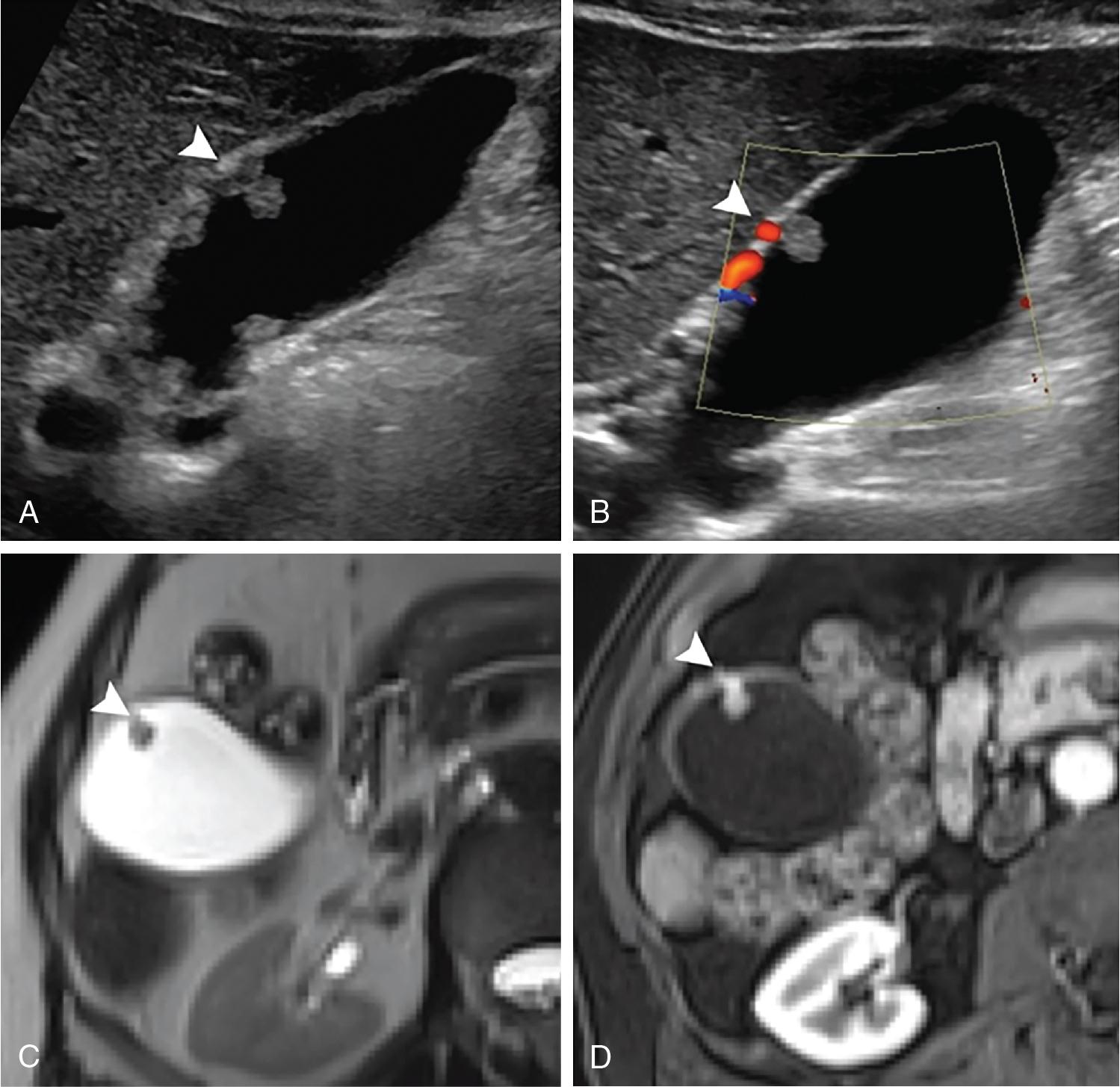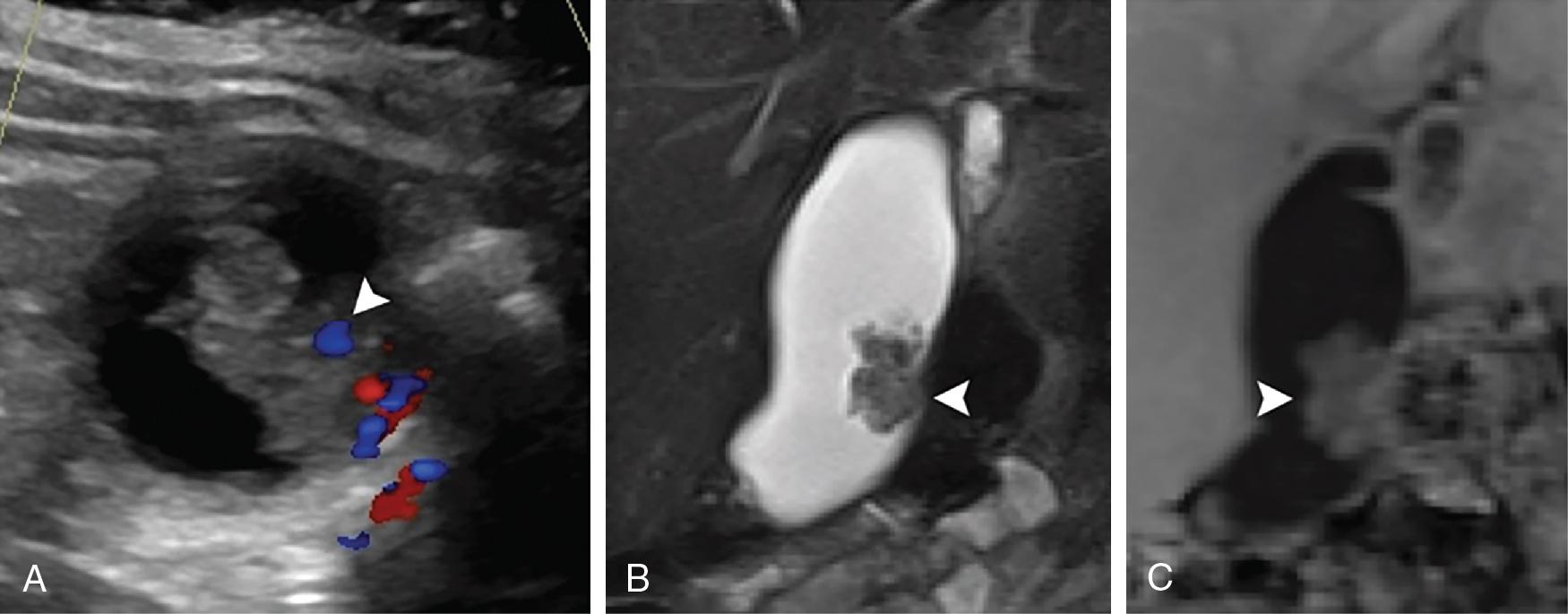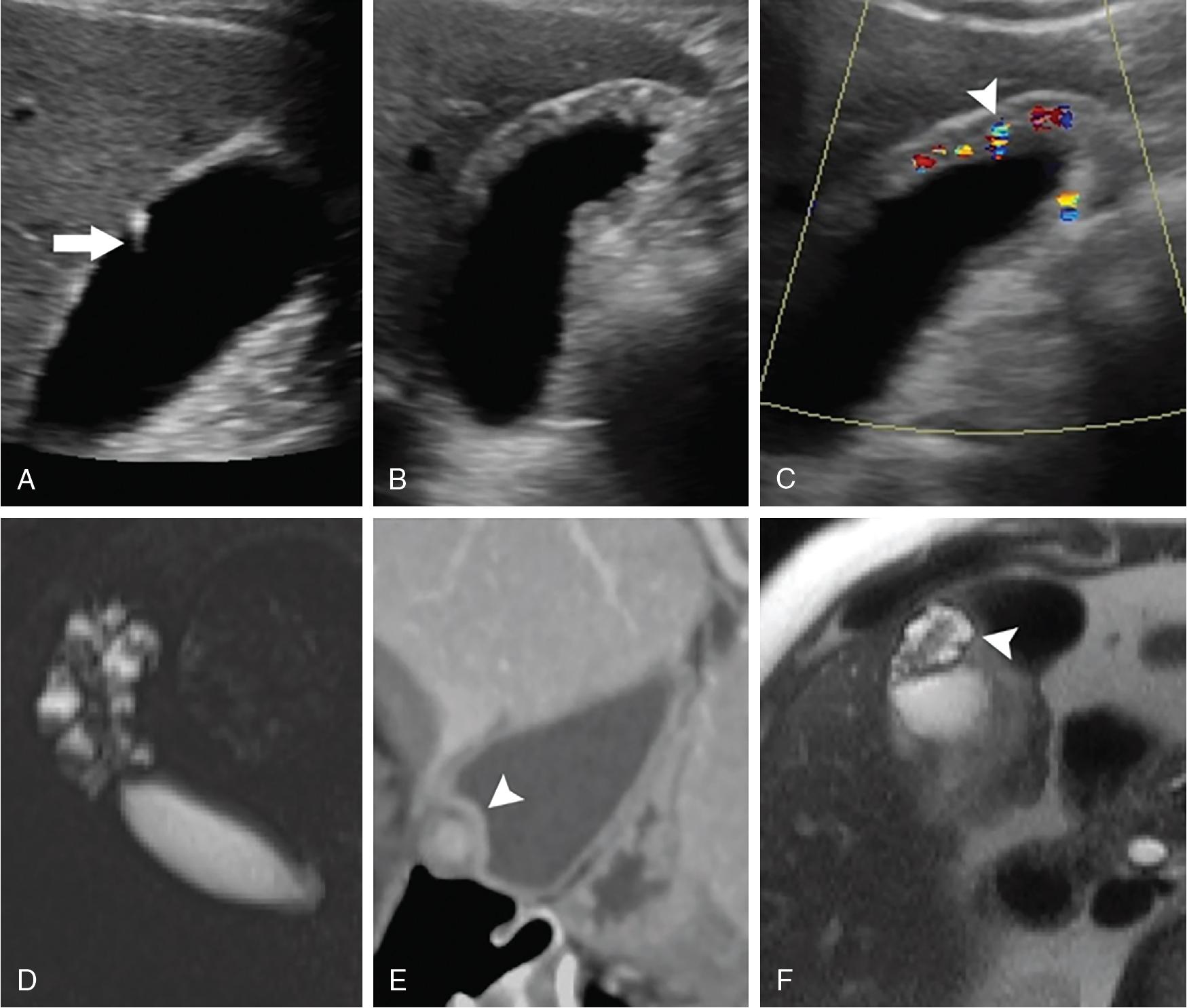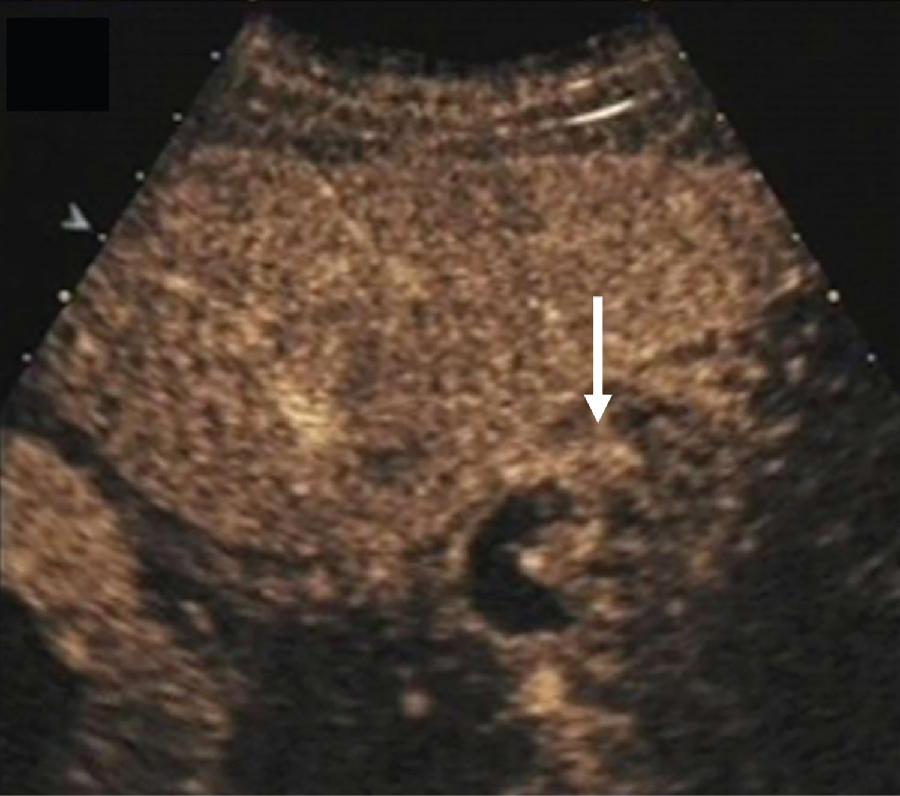Physical Address
304 North Cardinal St.
Dorchester Center, MA 02124
Although gallbladder cancer is a rare and aggressive malignancy that generally carries a dismal prognosis, there are a number of benign conditions of the gallbladder that can radiographically mimic malignancy and deserve consideration in a robust differential diagnosis because preoperative determination of a benign lesion may significantly alter treatment strategy.
Gallbladder polyps are found in approximately 3% to 7% of abdominal ultrasound examinations and 2% to 12% of cholecystectomy specimens. The majority (50%–80%) of polypoid lesions of the gallbladder are cholesterol polyps, which carry no malignant potential. , , , Cholesterol polyps are most commonly found in women aged 40 to 50 years during evaluation for epigastric or right upper quadrant abdominal pain. They may be single or multiple and generally are less than 10 mm in size. , , Pathologically, cholesterol polyps are nonneoplastic collections of lipid laden macrophages covered in normal gallbladder epithelium. They are typically smooth or lobulated and attached to the gallbladder wall by a stalk. Radiographically, cholesterol polyps are brightly echogenic without shadowing on ultrasound ( Fig. 49.1 ). Although larger polyps are less echogenic than smaller ones, they contain characteristic echogenic foci that may differentiate large cholesterol polyps from adenomas or adenocarcinomas. , These lesions may be safely observed as long as they are less than 10 mm in size.

Adenomatous polyps, or adenomas, are neoplastic lesions derived from the gallbladder epithelium that make up approximately 15% of gallbladder polyps. , Adenomas are more commonly found in women and are typically asymptomatic but may be associated with chronic right upper quadrant abdominal pain if large or obstructing the cystic duct. Adenomas are commonly associated with cholelithiasis. Histologically, adenomas may be tubular, papillary, or tubulopapillary as well as sessile or pedunculated. , Radiographically, adenomas are smooth intraluminal masses, although occasionally they may appear lobulated or cauliflower-like ( Fig. 49.2 ). Importantly, the adjacent gallbladder wall maintains a normal thickness of less than 3 mm in the case of a benign adenoma , (see Chapter 47 ).

Although the minority of adenomatous polyps transform into adenocarcinoma, malignant transformation does occur, and a high degree of suspicion is warranted given the vastly improved overall survival in patients with early-stage gallbladder cancer compared with advanced disease. Previously cited risk factors for gallbladder cancer include older age, specifically older than 50 years, presence of gallstones, larger polyp size (>10 mm), and isolated gallbladder wall thickening. Classically, guidelines have recommended cholecystectomy for polyps greater than 10 mm in size on preoperative imaging, and several studies have cited polyp size as the most reliable indication of malignant potential. For example, in a study of over 2000 patients who underwent cholecystectomy for polypoid lesions, Li and colleagues found that 90% of patients with gallbladder cancer had lesions greater than 10 mm. Further, Zielinski and colleagues found that 100% of gallbladder cancers occurred in patients with polyps at least 6 mm in size. Additional characteristics independently associated with malignancy in the setting of polypoid lesions included a history of primary sclerosing cholangitis, local gallbladder wall invasion, and polyp vascularity. Based on these data, citing a negative predictive value of 100%, and the absence of randomized controlled trials (RCTs) to guide decision making, the most recent guidelines from the Society of American Gastrointestinal and Endoscopic Surgeons (SAGES) recommend cholecystectomy for larger, especially single, polyps and those causing symptoms, and watchful waiting for asymptomatic polyps less than 5 mm in size. Generally speaking, polyps greater than 10 mm in size should be removed with a cholecystectomy.
Adenomyomatosis, also known as adenomyomatous hyperplasia, is present in 8% to 10% of cholecystectomy specimens and is associated with chronic inflammation of the gallbladder. , Adenomyomatosis can present in three variants: (1) localized (30%), presenting as a mass in the gallbladder fundus and accounting for approximately 11% of gallbladder polyps, (2) segmental (>60%), presenting as focal, circumferential gallbladder wall thickening, and (3) diffuse (<5%), presenting with diffuse gallbladder wall thickening and intramural diverticulae. Histologically adenomyomatosis is characterized by epithelial and smooth muscle proliferation, causing epithelial invaginations, or Rokitansky-Aschoff sinuses that form cystic spaces within the gallbladder wall ( Fig. 49.3 ). Adenomyomatosis is responsible for approximately one-quarter of cases of gallbladder wall thickening and is identified on abdominal ultrasound by the characteristic comet-tail artifacts, resulting from acoustic reverberations from calcium deposits trapped in the Rokitansky-Aschoff sinuses. Although dysplasia, carcinoma in situ, and invasive adenocarcinoma can form within the epithelium of adenomyomatous hyperplasia, adenomyomatosis itself is considered a benign lesion and not a malignant precursor. , Cholecystectomy is indicated in symptomatic cases or when differentiation from neoplastic thickening is a concern.

Granular cell tumors are nonepithelial tumors that occur throughout the body. One percent of granular cell tumors occur in the biliary tract, and 4% of these biliary granular cell tumors occur in the gallbladder, thus making them very rare tumors. , The vast majority (90%) of patients with granular cell tumors are women and the average age of presentation is 34 years. Granular cell tumors occur predominantly in African Americans and often present with symptoms of biliary colic or acute cholecystitis. , Histologically granular cell tumors are thought to be of Schwann cell origin and are S-100 positive on immunohistochemical staining. Radiographically, granular cell tumors appear as heterogeneous, mildly hyperechoic, poorly defined masses on ultrasound, and as nonspecific soft tissue masses on computed tomography (CT). Cholecystectomy is indicated for symptomatic lesions or when there is difficulty distinguishing it from a neoplastic polyp.
A comprehensive list of benign tumors of the gallbladder is presented in Table 49.1 .
| EPITHELIAL LESIONS | NONEPITHELIAL LESIONS | NEUROGENIC LESIONS | TUMOR-LIKE LESIONS |
|---|---|---|---|
|
|
|
|
Incidence of gallbladder cancer varies greatly worldwide and is highest in India (10–22 cases per 100,000), Asia (5–8 per 100,000), Eastern Europe (2–4 per 100,000), and South America (9–14 per 100,000). Incidence in the United States is comparatively low, with 1 to 2 cases per 100,000 persons; however, gallbladder cancer is the sixth most common gastrointestinal (GI) malignancy and the most common biliary tract malignancy in the United States. Geographic differences in risk factor prevalence likely explain some of this variation. For example, gallstone disease is a well-cited risk factor for gallbladder cancer because of mechanical injury, promotion of bacterial colonization, and chronic inflammation. Gallstone disease is highly prevalent in Chile (where 36% of women and 16% of men are affected); similarly, cholelithiasis is common in Hispanic and Native American populations in the United States, who also are at higher risk for gallbladder cancer compared with the general population. , Higher risk of gallbladder cancer with obesity, multiparity, and an approximately 3-fold increased risk in women compared with men is also presumably linked to higher incidence of gallstone disease, as all three of these characteristics are independent risk factors for stone development. Interestingly, although gallstones are present in 80% of cases of gallbladder cancer in India, the incidence of gallbladder cancer is higher than expected based on the prevalence of cholelithiasis in this country, indicating other risk factors may be playing a larger role (see Chapter 33 ). Additional risk factors, including low socioeconomic status, as a surrogate for decreased access to healthcare and specifically cholecystectomy, chronic Salmonella typhi infection, Helicobacter pylori infection, exposure to various pollutants and chemicals, and smoking, have also been implicated in higher rates of gallbladder cancer in specific populations. In contrast, the majority of gallbladder cancers diagnosed in Japan are not associated with gallstone disease, and furthermore, incidence is equal between men and women. However, presence of a K-ras mutation, anomalous pancreaticobiliary junction, and deregulatory mutations in the TP53 gene are more common in Japan and these molecular differences may result in the high incidence in that country. , ,
Despite these etiologic or pathogenic differences, from a prognostic standpoint, disease extent at diagnosis is the most important predictor of survival as demonstrated by Butte and colleagues. In examining cases of gallbladder cancer from three academic centers in the United States, Chile, and Japan, the authors found no differences in disease-specific survival (DSS) between countries after curative intent resection but instead cited higher T-stage and lymph node involvement as being associated with decreased overall survival on multivariable analysis.
Patients with gallbladder cancer present in one of three ways: (1) malignancy is diagnosed on final pathology after cholecystectomy for presumed benign disease, (2) malignancy is discovered during cholecystectomy for presumed benign disease, and (3) malignancy is suspected preoperatively. Malignancy diagnosed during or after cholecystectomy for benign disease will further be referred to as “incidental” gallbladder cancer. Clinical presentation of incidental gallbladder cancer most commonly involves abdominal pain or symptoms consistent with biliary colic and/or acute or chronic cholecystitis. More advanced disease may present with jaundice, malaise, weight loss, and a palpable mass.
Generally, there is no set pattern of laboratory values that raises specific suspicion for gallbladder cancer. However, Pitt and colleagues found that along with age over 65 years, female sex, and Asian or African American race, elevated alkaline phosphatase was associated with an increased risk of incidental gallbladder cancer diagnosis. Laboratory values consistent with chronic disease, including anemia, hypoalbuminemia, and leukocytosis, can be seen in the context of advanced disease, as well as hyperbilirubinemia and an elevated alkaline phosphatase.
Tumor markers are generally not helpful in diagnosing gallbladder cancer. However, both carcinoembryonic antigen (CEA) and carbonic anhydrase 19-9 (CA19-9) may be elevated in patients with gallbladder cancer and can be used to monitor for recurrence after treatment.
Ultrasonography is typically the initial imaging modality employed to investigate the gallbladder (see Chapter 16 ). On ultrasound examination, gallbladder cancer may appear as a mass replacing the gallbladder or invading the gallbladder bed (45%–60% of cases), irregular wall thickening (20%–30% of cases) or as an intraluminal polyp or mass (15%–25% of cases). , , In cases of advanced disease, standard ultrasonography has a sensitivity of 85%; however, gallbladder cancer can also mimic intramural changes of complicated cholecystitis (see Chapter 34 ). Early-stage disease, especially when associated with sessile polyps or gallstones, is difficult to identify. , , The use of color Doppler ultrasonography can identify increased blood flow to a lesion, which has been associated with malignancy; however, this is of controversial diagnostic value. , , Intravenous (IV) contrast enhanced ultrasound (CEUS) was developed over the past two decades and historically used for liver tumor pathology. In 2012 guidelines for examination of extrahepatic biliary structures were introduced, but these guidelines differentiated benign and malignant lesions by polyp size greater than 10 mm and clinical characteristics. , However, CEUS has been studied by several groups to identify characteristics of gallbladder malignancy.
Liu and colleagues, in a multicenter study of 9 hospitals in China, evaluated 192 patients with histologically confirmed gallbladder pathology, including 51 cases of adenocarcinoma. The authors found that while both benign and malignant lesions enhanced during the arterial phase of CEUS, malignant lesions were more likely to enhance heterogeneously and had a faster washout time of 41.4 seconds compared with 58.2 seconds in benign lesions. Malignant lesions were also more likely to have branched or linear intralesional vessels during the arterial phase, whereas benign lesions were more likely to present with dotted intralesional vessels. On multivariable analysis, the authors found branched or linear intralesional vessels (sensitivity 74.8%, specificity 98%) and gallbladder wall destruction adjacent to the lesion (sensitivity 78.4%, specificity 92.9%) as the best predictors of gallbladder cancer using CEUS ( Fig. 49.4 ).

Zhang and colleagues performed a similar study comparing CEUS with conventional ultrasound on 105 gallbladder lesions, including 18 cases of gallbladder cancer. Lesions were evaluated by both conventional ultrasound and CEUS and rated as benign, probably benign, probably malignant, and malignant using both modalities. CEUS was found to have higher sensitivity (94.1% vs. 82.4%), specificity (95.5% vs. 89.8%), positive predictive value (80.0% vs. 60.9%), negative predictive value (98.8% vs. 96.3%), and accuracy (95.2% vs. 88.6%) compared with conventional ultrasound, and although these differences were not statistically significant, the authors concluded that CEUS may provide value in the differential diagnosis of gallbladder lesions. The most recent guidelines written in 2017 by the European Federation of Societies for Ultrasound in Medicine and Biology state that CEUS “improves the diagnosis of malignant gallbladder polyps and wall thickening over [conventional] ultrasound. In gallbladder malignancy (protruding lesions as well as circumferential wall thickening), a heterogeneous enhancement pattern, the presence of perfusion defects, and an irregular vessel pattern were found to be typical features with [CEUS].” Although the microbubble contrast agent used in CEUS has been approved by the Food and Drug Administration (FDA) in the United States, as of this writing, its use is mostly limited to research activities, rather than standard clinical practice. However, CEUS is widely used in Europe and Asia.
If gallbladder cancer is suspected preoperatively, a multiphase CT scan or contrasted magnetic resonance imaging (MRI) of the abdomen and pelvis and a CT of the chest is indicated (see Chapter 16 ). The purpose of cross-sectional imaging is 3-fold: to define local extent of disease, to evaluate for nodal metastases, and to evaluate for distant metastatic disease. Because complete resection is the only possibility for cure in gallbladder cancer, accurate determination of tumor resectability is paramount, especially given that only 20% to 30% of patients present with tumors amenable to resection. Choi and colleagues investigated the association between CT findings and final resection margin and found that liver invasion, bile duct invasion, and hepatic artery involvement were associated with a positive margin on final pathology with a specificity of 93.3% when combining two or three of the aforementioned criteria. Tumor size, tumor morphology, hepatic versus peritoneal side involvement, and portal vein involvement were not independent predictors of positive resection margin on multivariable regression. Adequate radiographic evaluation of distant lymph nodes is likewise critically important because prognosis after resection is drastically reduced when lymph node metastases outside of the hepatoduodenal ligament are present. There is debate as to the ideal imaging modality for lymph node evaluation; de Savornin Lohman and colleagues performed a systematic review investigating the diagnostic accuracy of CT and MRI in identification of lymph node metastases. The sensitivity of both CT and MRI in the included studies varied widely, from 25% to 93% in CT and 59% to 92% in MRI exams. The modalities were not directly compared. In current clinical practice, the majority of patients are evaluated with a CT scan of the abdomen and pelvis, likely because of ease of examination performance in conjunction with a CT of the chest, less time required to complete the examination, and patient comfort. Of note, all false-negative lymph nodes identified in the included studies were less than 10 mm in size, and there is potential that newer technology, including thinner slices, higher resolution, and diffusion-weighted MRI may improve diagnostic accuracy, although this has not yet been proven for gallbladder cancer.
Finally, 18 F-fluorodeoxyglucose positron emission tomography (FDG-PET) may provide additional information in the staging and work-up of patients with gallbladder cancer (see Chapter 18 ). Most biliary tract cancers are FDG-PET avid, and this has been used to detect occult metastatic disease before resection of known cancers and to detect residual disease after cholecystectomy in incidentally diagnosed cases. Corvera and colleagues evaluated preoperative staging FDG-PET scans on 31 patients with gallbladder cancer. The results of these FDG-PET scans changed the stage and treatment of 23% of patients (the majority of whom had previously undergone multiple additional imaging studies) by identifying occult metastatic disease, rendering operative exploration unnecessary. The sensitivity and specificity of FDG-PET in these patients were 86% and 50%, respectively, for detecting the primary tumor, and 87% and 89%, respectively, for detecting metastatic disease, both local and distant.
In patients with incidental gallbladder cancer, FDG-PET has been shown to have a high specificity and accuracy in diagnosing residual disease in the gallbladder fossa (specificity 89.4%, accuracy 85.7%), regional disease (specificity 80.9%, accuracy 70.8%), liver metastases (specificity 100%, accuracy 100%), and lymph node metastases (specificity 95.2%–100%, accuracy 90.4%–100%) after cholecystectomy. These data were published by Shukla and colleagues who evaluated 24 patients referred for consideration for radical resection after cholecystectomy and incidentally diagnosed gallbladder cancer. Patients received both FDG-PET-CT and multidetector CT (MDCT) scans. The authors concluded that the imaging modalities have complimentary uses in patients with incidental gallbladder cancer, with the specific strength of FDG-PET-CT cited as detection of occult metastatic disease in the body outside the fields captured by MDCT. Of note, residual inflammation in the gallbladder fossa from the index cholecystectomy must be considered when interpreting a positive finding on FDG-PET done before performing re-resection of an incidentally discovered gallbladder cancer.
Butte and colleagues likewise examined patients with incidental gallbladder cancer with FDG-PET-CT for evaluation of residual disease before radical re-resection. Of 32 patients studied, 13 had a FDG-PET-CT that indicated no residual disease (negative), and 19 had evidence of residual disease (positive). Nine of these patients had evidence of locoregional and potentially resectable disease, and 10 had evidence of distant metastases. Of patients with negative FDG-PET-CT scans, 4 underwent reoperation; 3 had no residual disease on final pathology, and 1 patient was found to have peritoneal dissemination intraoperatively. Of patients with positive scans indicating potentially resectable disease, 4 underwent reoperation; 2 received a resection confirming locoregional disease, and 2 were found to have peritoneal dissemination. The authors concluded that use of FDG-PET in patients with incidental gallbladder cancer may reduce the number of patients undergoing nontherapeutic re-exploration after cholecystectomy; however, it is important to note the poor sensitivity of FDG-PET in detecting peritoneal disease, quantified as 28.5% by Shukla and colleagues in the previously discussed study. , Ultimately, identifying the optimal imaging modality or modalities for staging and determining resectability in occult gallbladder cancer and for identifying residual disease, restaging, and determining resectability in incidental gallbladder cancer requires further investigation. Overall, it appears that a multimodal approach may provide the most accurate and detailed information for treatment planning.
Because gallbladder cancer has the tendency and ability to seed the peritoneum, biopsy tracts, and surgical wounds, preoperative tissue diagnosis via fine-needle aspiration or core biopsy is generally not recommended. Cholecystectomy, in the case of known gallbladder cancer to provide a preoperative pathologic diagnosis, is also not advised because disruption of the gallbladder integrity and iatrogenic tumor dissemination leading to peritoneal implants may preclude curative resection, as has been described by Fong and colleagues. Risks of dissemination aside, Akosa and colleagues determined that fine-needle aspiration had an acceptable sensitivity for preoperative diagnosis of gallbladder cancer of 88%. Exfoliative cytology of bile was found to have a sensitivity of 50%; however two cases of endoscopic brushings evaluated yielded false-negative results.
Current clinical guidelines recommend biopsy only in the case of unresectable disease. Patients with resectable disease should proceed to definitive resection and the surgeon and patient should be prepared for the possibility of a resection being performed for benign disease, which, given the dismal prognosis of gallbladder cancer, is an acceptable risk when a high degree of suspicion for malignancy is present based on preoperative imaging. ,
The vast majority of gallbladder cancers are adenocarcinomas and the association of adenomatous polyps with increased risk of cancer suggests that the adenoma to adenocarcinoma sequence occurs in some patients (see Chapter 47 ). Approximately 60% of tumors originate in the fundus, 30% in the body, and 10% in the neck of the gallbladder. Tumors of the neck, infundibulum, or cystic duct may infiltrate the porta hepatis, in a presentation that mimics hilar cholangiocarcinoma, resulting in major vascular invasion and obstructive jaundice. Grossly, gallbladder cancers may be categorized as (1) infiltrative, causing diffuse thickening and induration of the gallbladder wall, (2) nodular, presenting as a well-circumscribed mass, (3) combined nodular-infiltrative, (4) papillary, with a frond-like, cauliflower appearance and the best prognosis because of limited invasion into the gallbladder wall, and (5) combined papillary-infiltrative forms.
Although adenocarcinoma makes up 90% of malignant gallbladder tumors, there are several rare histologies that deserve mention ( Box 49.1 ). Squamous differentiation is not uncommon in gallbladder cancer, often mixed with adenocarcinoma; pure squamous cell carcinoma (SCC) accounts for 2% to 3% of all malignant gallbladder tumors. The available data regarding this histology are limited to case reports, although from these cases, SCC appears to proliferate at a faster rate than adenocarcinoma and tends to involve locally advanced/infiltrative tumors, often invading the entire gallbladder wall. Interestingly, SCC tumors appear to have less of a tendency to metastasize to regional lymph nodes than adenocarcinoma, and the poor 5-year overall survival of approximately 1% has been attributed to early direct invasion into the liver and other adjacent organs. Adenosquamous carcinoma of the gallbladder is similarly rare and often grouped with SCC in the literature. Chan and colleagues compared 12 patients with adenosquamous carcinoma of the gallbladder and 2 patients with SCC with 140 patients with adenocarcinoma. The authors found similar clinical characteristics in the two groups, but more advanced T stage and higher rates of liver involvement in the predominantly adenosquamous group and similarly poor outcomes for all histologies.
• Adenocarcinoma (90%)
• Squamous/adenosquamous (2%–3%)
• Neuroendocrine (2%–3%)
• Clear cell
• Sarcoma
• Melanoma
• Lymphoma
• Metastases
Primary neuroendocrine tumors (NET) of the gallbladder account for approximately 2% to 3% of malignant gallbladder tumors. Ayabe and colleagues conducted an analysis of 754 patients with primary neuroendocrine tumors of the gallbladder in the National Cancer Database from 2004 to 2015. The authors found a longer median overall survival in patients with neuroendocrine gallbladder tumors compared with patients with gallbladder adenocarcinoma (25 months vs. 17 months, P = .001). However, overall survival (OS) in resected gallbladder neuroendocrine tumors was significantly worse than in neuroendocrine tumors of other sites (Median OS: gallbladder NET: 25 months; small bowel NET: 130 months; colon NET: 65 months; pancreas, appendix, stomach, rectum NET: median not reached, P < .001). Reports of both primary and metastatic melanoma of the gallbladder, gallbladder sarcoma, lymphoma, and clear cell carcinoma of the gallbladder have been published, but these tumors are exceedingly rare.
Become a Clinical Tree membership for Full access and enjoy Unlimited articles
If you are a member. Log in here